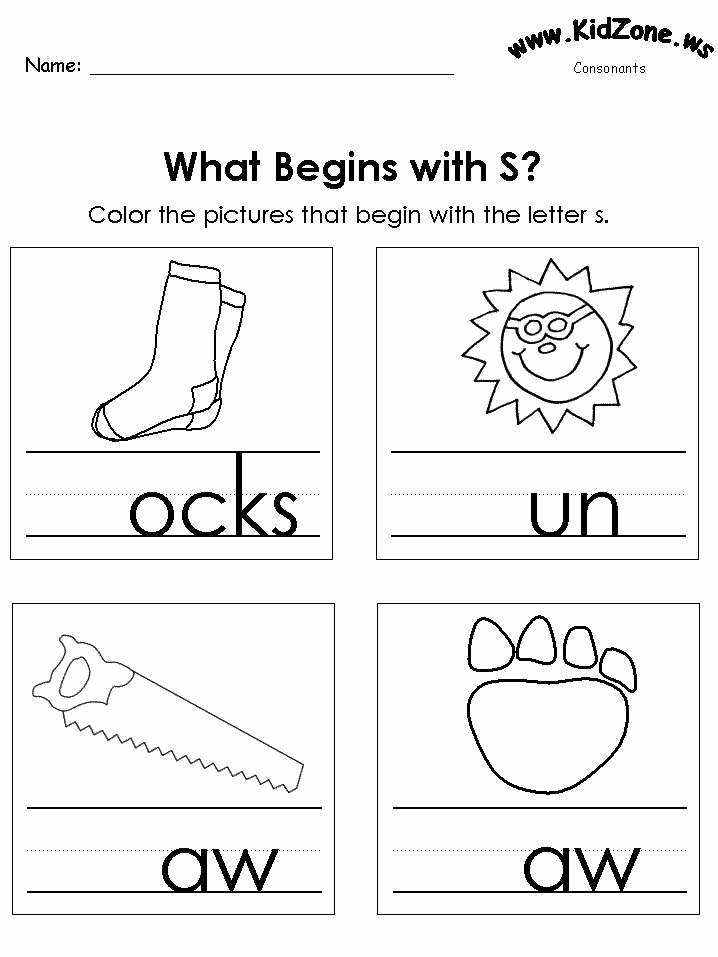Emergent Literacy Design
Learning About S with Sam the Snake!

Rationale: This lesson will help children identify /s/, the phoneme represented by S. Students will learn to recognize /s/ in spoken words by learning a meaningful representation (the shape of a snake) and the letter symbol S, practice finding /s/ in words, and apply phoneme awareness with /s/ in phonetic cue reading by distinguishing rhyming words from beginning letters.
Materials: Primary paper and pencil; chart with "Sam the snake saw a star in the sky."; drawing paper and crayons; The Sneetches: and Other Stories (Random House, 1961); word cards with SAD, CAP, SET, SHE, and SO; assessment worksheet identifying pictures with /s/ (provided below).
Procedures:
1. Say: Our written language is a secret code. The tricky part is learning what letters stand for—the mouth moves we make as we say words. Today we're going to work on spotting the mouth movement /s/. We spell /s/ with letter S. S looks like a snake, and /s/ sounds like a snake hissing. Ssss ssss!
2. Say: Let's pretend to be a snake, /s/, /s/, /s/. [Make a waving vertical line in the air while making the /s/ sound]. Hide your tongue behind your teeth, and keeps your lips like a smile. Then make a skinny string of air blow out of your mouth!
3. Say: Let me show you how to find /s/ in the word disk. I'm going to stretch disk out in super slow motion and listen for my snake. Diii-sss-kk. Slower: Diiii-sssss-kkk There it was! I felt the skinny string of air come out of my mouth! I can feel the snake /s/ in disk.
4. Say: I'm going to tell you a story about Sam the snake. Sam was very interested in what the sky looked at night, but he was always too sleepy to stay awake and see it! One day he decided to sleep during the day, so he could see what the sky looked like when it got dark. Right when the sun set, Sam the snake saw a star in the sky. [Show chart]. " Sam the snake saw a star in the sky." Everybody say it three times together. Now say it again, and this time, stretch the /s/ at the beginning of the words. " Ssssssam the ssssssnake sssssaw a ssssstar in the ssssssky." Try it again, and this time break it off the word: " /s/am the /s/nake /s/aw a /s/tar in the /s/ky.”
5. [Have students take out primary paper and pencil, then illustrate on the board while giving directions]. Say: We use letter S to spell /s/. Capital S looks like a snake. Let's write the lowercase letter s. It looks just like the uppercase S, but is smaller. Start on the fence. Start to make a little c and stop between the fence and the sidewalk, then change directions and scoop it up, like a backwards c, making sure it touches the sidewalk. I want to see everybody's s. After I put a sticker on it, I want you to make nine more just like it.
6. [Call on students to answer and tell how they knew]. Say: Do you hear /s/ in sun or moon? Saw or paw? Happy or sad? Sleep or deep? Say: Let's see if you can spot the mouth move /s/ in some words. Make a snake with your finger and hiss if you hear /s/: is, fox, the, safe, sink, cat, black, glass, school.
7. Say: "Let's look at a book called The Sneetches! Dr. Seuss tells us about two types of creatures: ones with stars on their bellies, and ones without. The Star-Belly Sneetches think they are the best, and look down upon Sneetches without stars." [Read The Sneetches, drawing out /s/ in Sneetches and stars. Ask children if they can think of other words with /s/. Ask them to draw a picture of an object that starts with S that they would put on their Sneetch’s belly. Then have each student write the name of their object with invented spelling. Display their work.]
8. [Show SAD and model how to decide if it is sad or mad]. Say: The S tells me to hiss like a snake, /s/, so this word is ssssad, sad. You try some: SO: so or no? SET: met or set? SHE: she or me? CAP: cap or sap?
9. [For assessment, distribute the worksheet provided below. Students are to complete the partial spellings and color the pictures that begin with S. Call students individually to read the phonetic cue words from step #8.]
References:
Hester, Malorie. Sammy the Snake Says...Ssssss. https://sites.google.com/site/mshesterslessons/home/emergent-reader-lesson
Click here to return to the Entries index.
